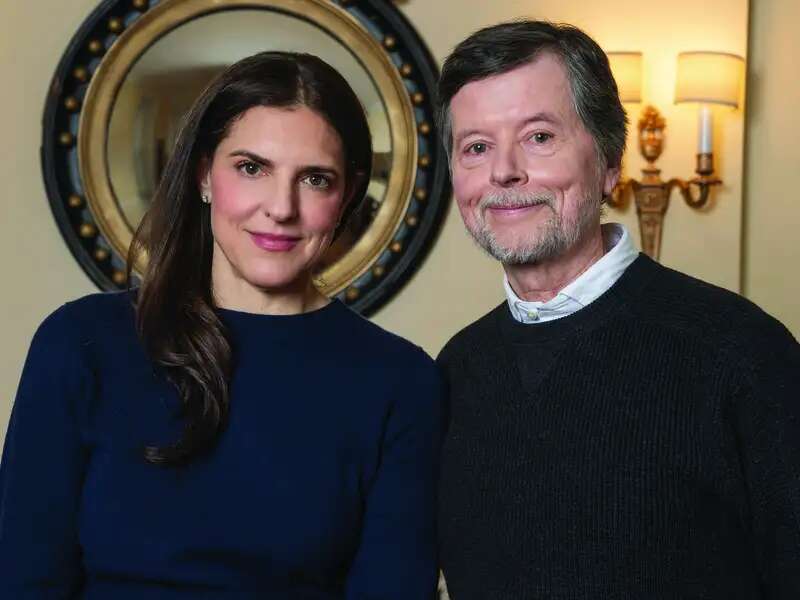
Ahead of Ken Burns’s Latest Docuseries, Co-Director Sarah Botstein '94 Shares her Path, Process.
When Amy Hwang ’00 started drawing cartoons as a freshman for the Columbia Daily Spectator, little did she know that this extracurricular activity would one day develop into a full-time profession. After graduating from Barnard with a B.A. in architecture, Hwang found a job working for an architecture firm. On a whim, she sent in her first cartoons to The New Yorker via snail mail, but it wasn’t until her late 20s that she pursued cartooning seriously. Since then, she’s built up an impressive portfolio, with her work regularly featured in the pages of The New Yorker as well as other outlets, including in the weekly emails of Usual Wines and in EatingWell magazine.
Hwang’s cartoons are often inspired by personal experience, and at the heart of each one, you find a candor and playfulness that underscore the nuances of everyday realities. “I think cartoonists are good at seeing the world in a way that cuts to the truth of a matter. We see incongruences and bring them to life,” Hwang explained in her 2019 TEDxYale talk. And her work has garnered industry recognition: The National Cartoonists Society presented Hwang with the 2019 Silver Reuben Award for Best in Gag Cartoons. We asked Hwang to complete our Sketchbook questionnaire for a little insight into her creative process.
Where do you draw inspiration from?
My daily thoughts and observations.
Which classes at Barnard most informed your work?
Pulling all-nighters in the architecture studio reinforced my appreciation for sleep. The opposing concepts of misery and comfort are common to my cartoons.
What is your creative process like?
My process is a combination of brainstorming ideas and then finessing them up to the last minute. It helps to have the urgency of a deadline to come up with ideas, but I also like to have enough time to let them gestate. Then I look at them later with fresh eyes to see if they were funny to begin with.
How would you describe your style or aesthetic (in 3-5 adjectives)?
Soft, flat, and gray.
What is your favorite project or piece, and why?
I don’t have a favorite piece, but I can say that my more popular cartoons are not necessarily my favorites except that they earn more money in royalties.
Where would I have found you sketching or making artwork on campus?
In the back row of Schermerhorn 501 during an art history lecture, at the library, or in an actual art class.
What do you listen to while at work in your studio?
My answer to this varies day to day. Sometimes I listen to music — usually without words. Sometimes I have a television show or movie on in the background — something with a lot of words so I don’t have to look at the screen. I do not listen to podcasts because I find them too distracting.
Who is at your dream dinner party?
Other cartoonists. I don’t get to see cartoonist friends in person much, due to the nature of our work and because I live outside the city and have very little free time.
What artwork was on your dorm wall?
I had postcards of Edward Hopper paintings, a postcard of a sculpture by Duane Hanson (Woman with Dog), and one or two Sam Gross cat cartoons torn from a New Yorker daily calendar.
What’s your guilty pleasure?
Procrastination. I am not talking about procrastinating doing something like watching a movie. I wouldn’t be able to handle that level of guilt. I reorganize cabinets or complete a minor home improvement when I procrastinate.
What is your idea of perfect happiness?
Having the freedom to do what I want on my own terms.
What is your favorite place to see art?
For me, it is less about the place — NYC has many great museums — and more about having the space to see the art. I dislike crowds of people in museums.
Which living person do you most admire?
I have no idea. I do admire the younger generation, though, because I think positive change can happen with them.
What is your greatest extravagance?
Being a full-time cartoonist is an extravagance.
What is your current state of mind?
Usually I have an “I can do it” attitude with a veneer of calm, but sometimes I need to scream into a pillow.
What do you consider your greatest achievement?
Making it to every next day is a greater achievement than the one before. The culmination of my life to this point is the greatest achievement, for me. That is, until I’m dead.
Where would you most like to live?
I like where I live right now in Westchester. It’s not perfect, but I don’t think any place is. If my circumstances permitted, I would like to live in Taipei.
What is your most treasured possession?
I’ve been living with a baby/toddler/small child for the past 10 years — I’m not overwhelmingly attached to any material possessions. Everything I need is easily replaced with money, which is also replaceable. I suppose my home insurance policy is important to me, should I encounter widespread damage to my possessions.
Who are your heroes in real life?
Moms.
What is your motto?
“Patience and fortitude conquer all things.” It’s by Ralph Waldo Emerson.